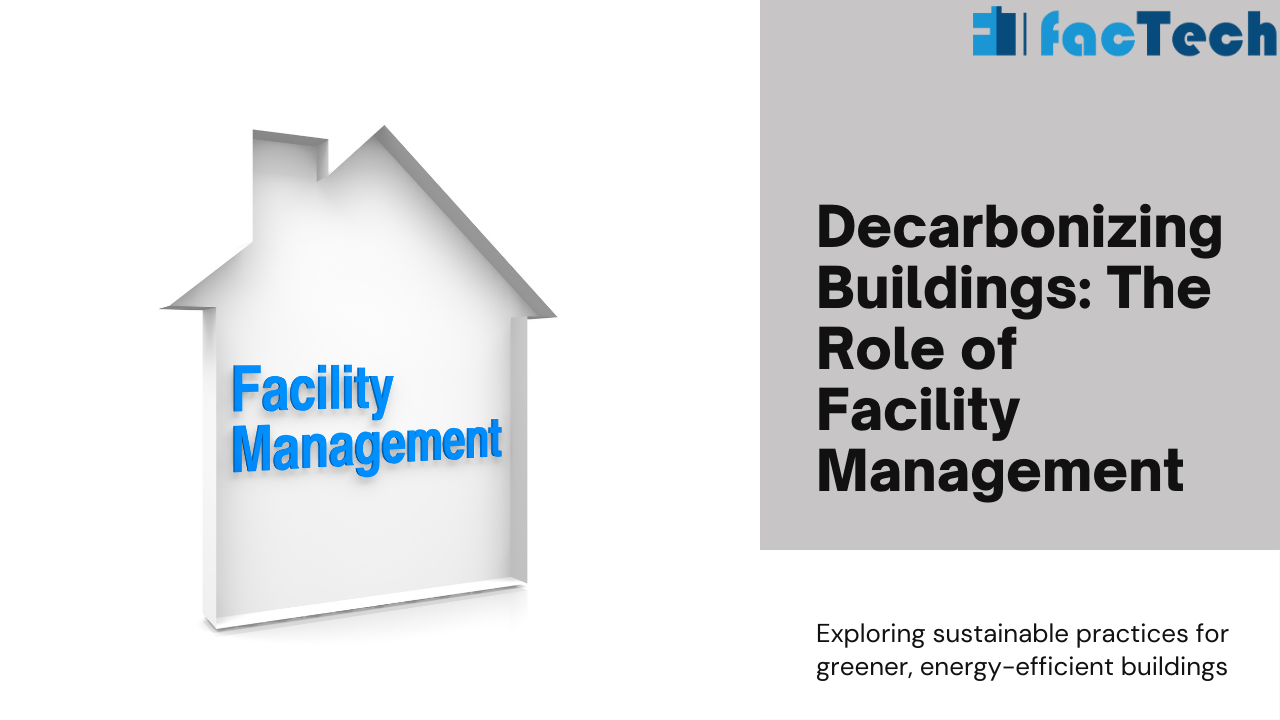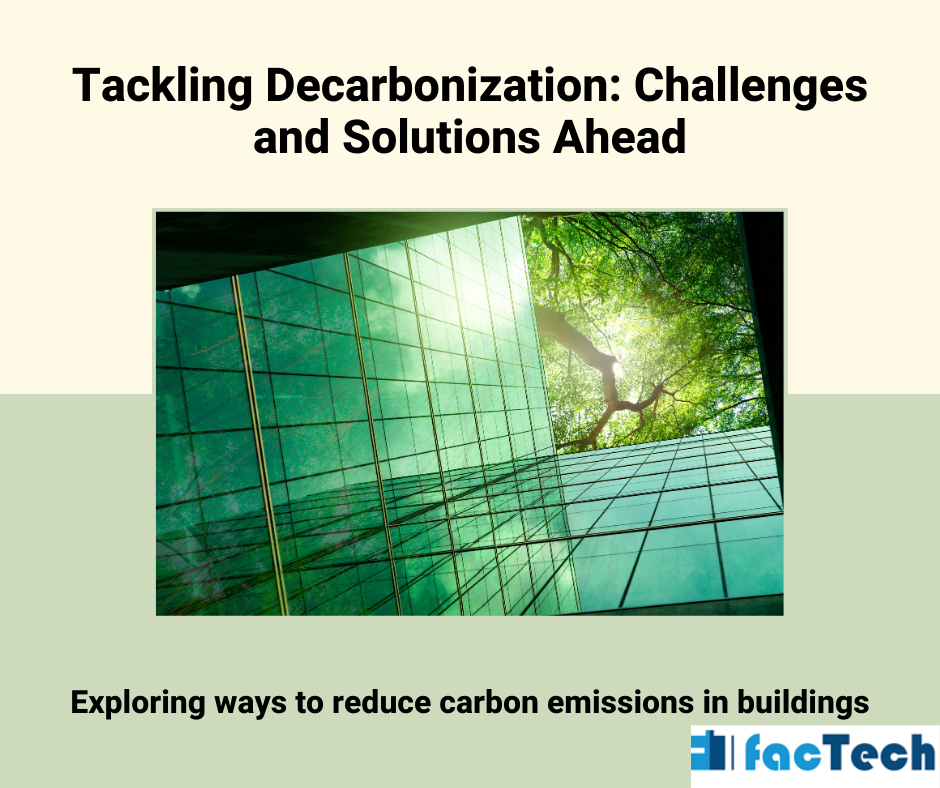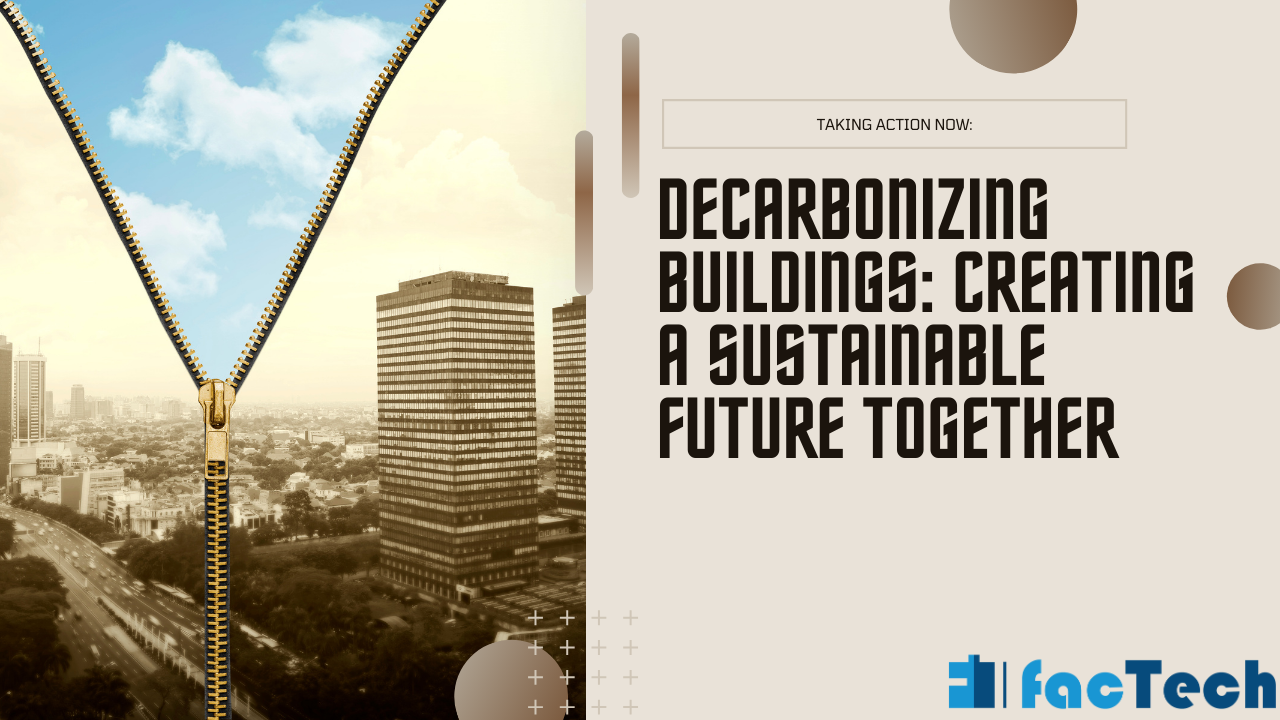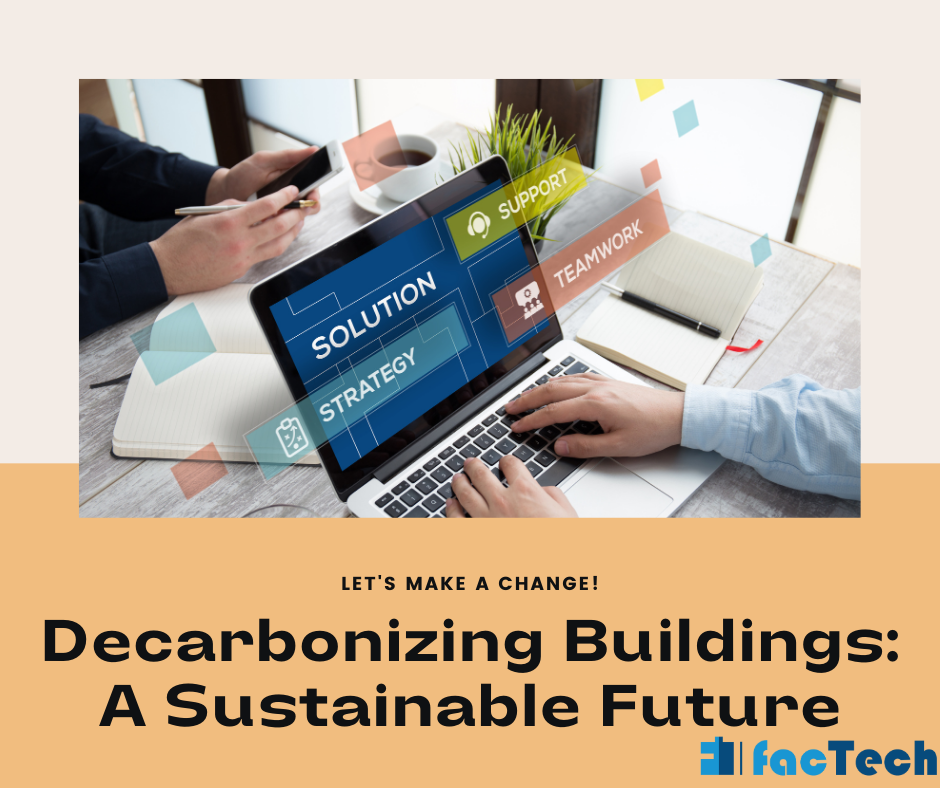How do we decarbonise buildings
How Do We Decarbonize Buildings
Building a Greener Future:
How to decarbonize Our buildings are a surprising culprit when it comes to climate change.
They account for a staggering nearly 40% of global energy-related CO2 emissions.
But this doesn’t have to be the status quo. By taking steps to decarbonize our buildings, we can make a significant impact on the environment while reaping other benefits.
Why Decarbonize?
There are several compelling reasons to decarbonize our buildings:
Climate Change:
Reducing greenhouse gas emissions is crucial for combating climate change. Decarbonization is a major step forward. One urgent concern is climate change, to which buildings contribute significantly. According to sources, they are responsible for an astounding 40% of the world’s greenhouse gas emissions. Facility managers are in a unique position to deal with this issue. Decarbonization techniques can be used to drastically lessen a building’s environmental effect.
Energy Savings:
Many decarbonization strategies, like improving energy efficiency, can lead to lower energy bills for building owners and occupants.
Health Benefits:
Improved ventilation and air quality, often associated with decarbonization efforts, can lead to better health outcomes for building occupants.
Although buildings contribute significantly to greenhouse gas emissions, the battle against climate change has unexpected advantages that are more locally felt, such as better public health. Reducing the amount of fossil fuels that buildings use, or “decarbonizing,” is not only excellent for the environment but also for human health.
Decarbonizing buildings: An Enzyme for Air Purification
Fortunately, a lot of decarbonization techniques address air pollution from both indoor and outdoor sources. How to do it is as follows:
improved Insulation and Ventilation: Buildings can bring in more fresh air and trap less pollutants inside by installing improved ventilation systems and fixing leaks.
Renewable Energy: By switching to geothermal, wind, or solar energy, emissions from burning fossil fuels on-site are eliminated.
Energy-efficient appliances: By using less energy, contemporary appliances help to lower the global demand for fossil fuels.
Electrification: Indoor air pollutants such as nitrogen dioxide are eliminated when gas-powered equipment are replaced with electric counterparts.
Better Structures, Better People
Building occupants’ health directly benefits from these decarbonization activities. Research indicates that enhanced indoor air quality can result in:
Decreased incidence of respiratory issues, such as asthma, allergies, as well as respiratory ailments.
Better focus, concentration, and even higher levels of productivity are examples of improved cognitive function.
Improved health: Overall health can be enhanced by an environment that is more cozy and healthful inside.
Job Creation:
The transition to a low-carbon building sector can create new jobs in areas like renewable energy and energy efficiency retrofits.
The Function of Facility Management in decarbonizing buildings
Building operations rely heavily on facility managers. They manage every aspect, including maintenance and energy use. They therefore have a vital part to play in the decarbonization process. How they can differ is as follows:
Understanding a building’s energy use patterns is the first step in conducting an energy audit. Facility managers might find areas for improvement by starting energy audits.
Enhancing Structures:
Energy consumption can be greatly decreased by switching to energy-efficient equipment, such as smart HVAC systems and LED lights. Facility managers can lead these improvements and guarantee smooth functioning.
Building electrification:
A significant step toward decarbonization is swapping out fossil fuel-based systems with electric ones, such as heat pumps. Facility managers and engineers can collaborate to determine the viability of this plan and put it into action.
Integration of Renewable Energy:
On-site reliance on the grid can be further decreased by using solar or wind turbines to provide clean electricity for the building. Facility managers can investigate and suggest renewable energy options.
Engagement of Occupants:
It can have a significant effect on encouraging tenants to adopt sustainable behaviors like turning off lights in vacant places and regulating thermostats. Programs for changing occupant behavior and awareness can be implemented by facility managers.
The Boom in Job Creation
Numerous new career opportunities in facility management will arise as we begin this massive decarbonization effort:
Specialists in decarbonization: These professionals will know renewable energy sources, energy efficiency, and sustainable building techniques. They will be in charge of creating and carrying out decarbonization plans.
Building Automation Techs: To install, maintain, and troubleshoot these intricate systems as buildings become more automated, qualified technicians will be required.
Data analysts: To spot trends and enhance efficiency, the data gathered from building automation systems needs to be analyzed. Facility managers will need the assistance of data analysts in deciphering this information.
Read more:
How to Create a Greener Workforce
To take advantage of this potential for job growth, we must fund training initiatives that provide people with the skills for these new roles. This could involve:
Community College Programs: Creating specialist classes in data analysis, renewable energy, and decarbonization of buildings will broaden the pool of potential students.
Industry certificates: To prove proficiency to employers, the development of industry-recognized certificates for decarbonization specialists and building automation technicians would be beneficial.
On-the-Job Training: Provide incentives to established facility management firms so they will offer decarbonization-focused on-the-job training courses.
A Win-Win Situation
It is a win-win situation to decarbonize buildings through facilities management. Lowering our carbon footprint and developing a workforce with the skills necessary to meet this expanding challenge, makes the future greener. We can guarantee a smooth transition, generate new employment opportunities, and enable facility managers to emerge as the unsung heroes of the built environment by investing in training and certifications.
The Toolbox for Decarbonizing Buildings
While there isn’t a single decarbonization strategy that works for everyone, there are a few important ones that can be used:
Energy Efficiency:
Here’s where it starts. Buildings can reduce their overall energy use by employing high-efficiency equipment and lights, caulking air leaks, and enhancing insulation.
Renewable Energy:
Carbon emissions can be drastically decreased by switching from fossil fuel-based energy sources to renewable alternatives like geothermal heating, wind turbines, and solar panels.
Electrification:
Another important tactic is to swap out gas-powered heating systems and appliances for electric models that run on renewable energy.
Smart Building Technologies:
Systems for building automation that maximize energy efficiency and the comfort of occupants can be very important.
Issues and Resolutions
There are difficulties associated with decarbonization. The initial expenditures of retrofitting existing structures can be prohibitive. Government subsidies, financial choices, and incentives, however, can aid in closing the difference. Furthermore, the initial cost is frequently exceeded by the long-term energy savings. One of the challenges may be the upfront costs of upgrading and possible inconveniences during renovations. Managers of facilities can deal with these by:
Setting aside money-saving measures first: Start with free or inexpensive fixes, such as scheduling HVAC units more efficiently and altering occupant behavior.
Looking for monetary rewards: Examine government tax credits, refunds, and grants accessible for enhancing energy efficiency.
ROI demonstration: To get support for investments, perform cost-benefit evaluations and point out possible long-term energy bill reductions.
ROI Illustration: An Example
Consider a mid-sized office facility with a $50,000 yearly energy bill. A $20,000 upgrade in windows, lighting, and insulation might result in a 20% decrease in energy use and yearly savings of $10,000. The renovation would have a two-year payback period and result in significant cost reductions in the years that followed.
Extra Advantages Over ROI
Decarbonization has advantages beyond the bottom line. It additionally
Boosts Property Value: Tenants find energy-efficient buildings more appealing, which leads to higher rentals and quicker lease agreements.
Enhances Occupant Comfort: Stable and cozy interior environments are produced by effective systems.
Boosts Brand Image: Being a pioneer in sustainability builds a company’s reputation and draws in eco-aware workers and tenants.
Next Actions: Creating a Road Map for Decarbonizing buildings
Energy Audit: To find areas that need improvement, carry out a comprehensive energy audit. This will offer useful information for figuring out possible cost reductions and ROI.
Consult an Expert: Speak with experts in energy efficiency to create a personalized decarbonization strategy that takes into account the individual features of your building.
Financing Options: Look into financing programs, government rebates, and incentives that might lessen the financial strain of up-front expenses.
Creating a Better Tomorrow
We can make our buildings sustainable places that contribute to a cleaner future by putting these principles into practice. Decarbonization aims to make living and working environments healthier and more economical, not merely better for the environment. Legislators, building owners, and citizens can all contribute to bringing about this shift by cooperating.
FAQs
Why do decarbonizing buildings matter?
Buildings are a large source of emissions into the atmosphere, which plays a vital role in climate change. Decarbonization contributes to environmental health and the fight against climate change.
How can my building become carbon neutral?
Various methods exist, contingent on the kind of building and financial constraints. The following are some crucial tactics:
To increase energy efficiency, update insulation, plug air leaks, and buy energy-saving appliances and lighting.
Electrification: Replace fossil fuel-based heating and cooling systems (such as gas furnaces) with high-efficiency electric appliances and electric heat pumps.
Renewable energy: To produce clean electricity, install solar panels, wind turbines, or other on-site renewable energy sources.
Balance out the residual emissions: To offset inevitable emissions, think about buying carbon offsets.
What advantages do decarbonizing buildings offer?
Decreased influence on the environment: less greenhouse gas emissions help keep the earth healthy.
Savings on costs: Lower utility bills are a direct result of increased energy efficiency.
Enhanced property value: Tenants and buyers are finding sustainable buildings to be more and more appealing.
Enhanced comfort for tenants: Energy-efficient structures frequently offer greater air quality and temperature control.
Exist any monetary rewards for the decarbonization process?
Indeed, a lot of utilities and governments provide tax credits, rebates, and other financial incentives to promote the decarbonization of buildings. Look into the local programs that are offered.
Contact us for a free demo of how our expertise can help you achieve your business goals to the best.











